Lab 04 – Client Scripting
Scenario
A regional building department issues and tracks permits for new buildings and updates for remodeling of existing buildings. Throughout this course, you will build applications and automation to enable the regional building department to manage the permitting process. This will be an end-to-end solution which will help you understand the overall process flow.
In this lab, you will implement client-side logic that will use the web API to evaluate the permit type associated with the permit record and use the client scripting API to manipulate the form controls.
You will also customize the command bar to introduce a new lock permit button that will invoke a custom API to perform the lock permit logic. The server-side logic for the lock permit custom API will be implemented later in the course. Right now, you will just add the button and the logic to invoke the custom API.
High-level lab steps
As part of building the client-side logic, you will complete the following:
-
Setup a folder to contain your client script
-
Upload and register the client script on the form
-
Build logic to use the web API to retrieve the permit type record associated with the permit
-
Build logic based on the permit type settings to hide and show the inspections tab on the form
-
Build logic to set columns as required/not required based on the permit type settings
-
Modify the command bar
-
Build logic to invoke the lock permit custom API when the command bar button is selected
Things to consider before you begin
-
Are there alternative designs that would be viable and not require code?
-
Remember to continue working in your DEVELOPMENT environment. We will move everything to production soon.
Exercise #1: Prepare and Load Resources
Objective: In this exercise, you will create, organize, and load your JavaScript web resources.
Task #1: Use Visual Studio Code to Create Resources
In this task, you will set up a folder to contain the JavaScript web resource files in this course.
-
If you do not already have Visual Studio Code, download it from here Visual Studio Code and install it.
-
Start Visual Studio Code.
-
Create resources
- Select Explorer from left menu or press Ctrl + Shift + E.
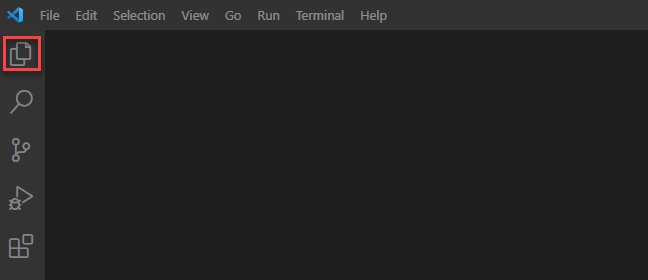
-
Select Open Folder.
-
Create a new folder and name it ContosoClientScripts.
- Select the new folder you just created and select **Select Folder**.

-
Create Form Scripts folder
- Hover over the folder and select New Folder.
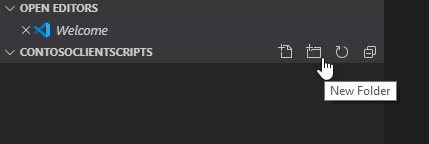
- Name the new folder as FormScripts and Enter.

-
Create the Permit Form Functions file
- Right click on the FormScripts folder and select New File.

- Name the new file as PermitFormFuntions.js and Enter.

-
Add the below mentioned namespaces to the newly created PermitFormFunctions file.
if (typeof (ContosoPermit) == "undefined") {var ContosoPermit = {__namespace: true};} if (typeof (ContosoPermit.Scripts) == "undefined") {ContosoPermit.Scripts = {__namespace: true};}

-
Add the function mentioned below after adding the namespaces.
ContosoPermit.Scripts.PermitForm = { __namespace: true }
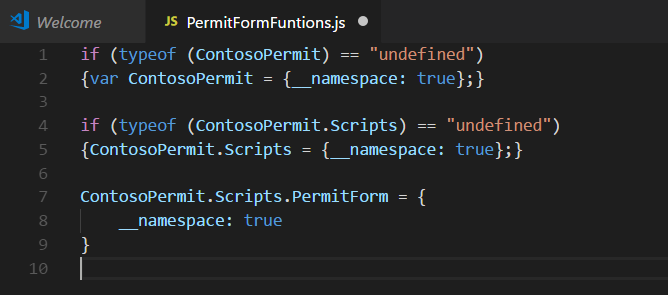
Task #2: Add Event Handlers
In this task, you will create functions for the logic that you will be implementing. This will allow you to register the event handlers in the next tasks for calling these functions and performing few basic tests in the upcoming tasks.
-
Add a function to OnLoad event
-
Add the function mentioned below to the PermitFormFuntions file inside the function created in Step 1(d).
handleOnLoad: function (executionContext) { console.log('on load - permit form'); },
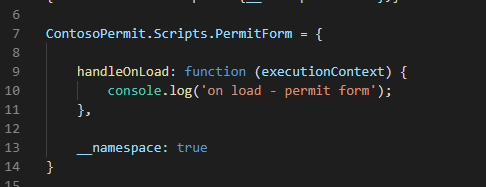
-
-
Add a function to OnChange permit type event
-
Add the function mentioned below to the PermitFormFuntions file inside the function created in Step 1(d). Once this is done, select File and Save All.
handleOnChangePermitType: function (executionContext) { console.log('on change - permit type'); },
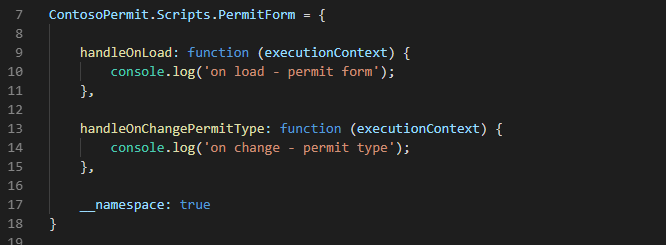
-
Task #3: Load Web Resources
In this task, you will upload the JavaScript files as web resources.You will also edit the Permit table main form and associate the new web resource with its form. Finally, you will register your functions to be called on specific form events.
-
Open the Permit Management solution
-
Sign in to Power Apps maker portal.
-
Select your Dev environment.
-
Select Solutions.
-
Open the Permit Management solution.
-
-
Add web resource to the solution
-
Select + New.
-
Select **More Web Resources**.
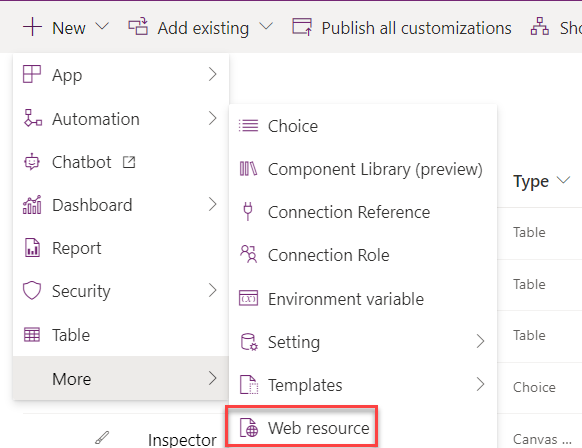
-
Enter Permit Form Scripts for Display name.
-
Enter PermitFormScripts.js for Name.
-
Select JavaScript (JS) for Type.
-
Select Upload file.
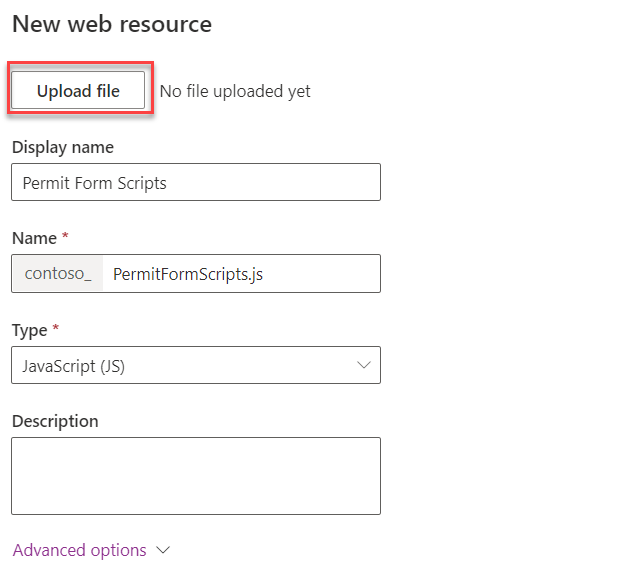
- Select the PermitFormFunctions.js file and select Open.

-
Select Save and wait until the changes are saved.
-
Select Publish all customizations and wait for the publishing to complete.
-
-
Open the Permit main form.
-
Make sure you are still in the solution.
-
Open the Permit table.
-
Select the Forms tab and open the Main form.
-
-
Add the script to the permit form
- Go to the Properties pane and select the Events tab.
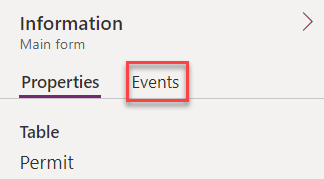
-
Select + Add library.
-
Search for contoso, select Permit Form Scripts and select Add.
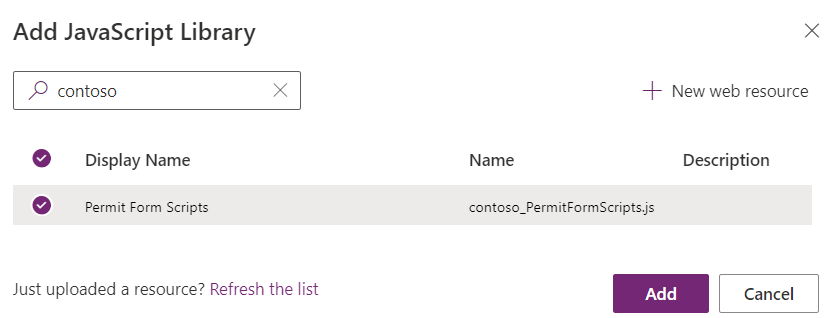
-
Add OnLoad event handler.
- Expand the OnLoad section and select + Event Handler.
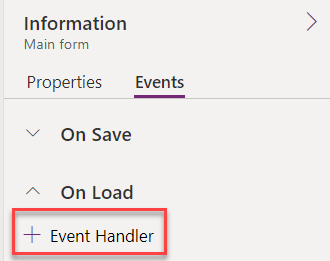
-
Select Contoso_PermitFormScripts.js in the dropdown for Library.
-
Enter ContosoPermit.Scripts.PermitForm.handleOnLoad in the textbox for Function.
-
Check the Pass execution context as first parameter checkbox.
-
Select Done.
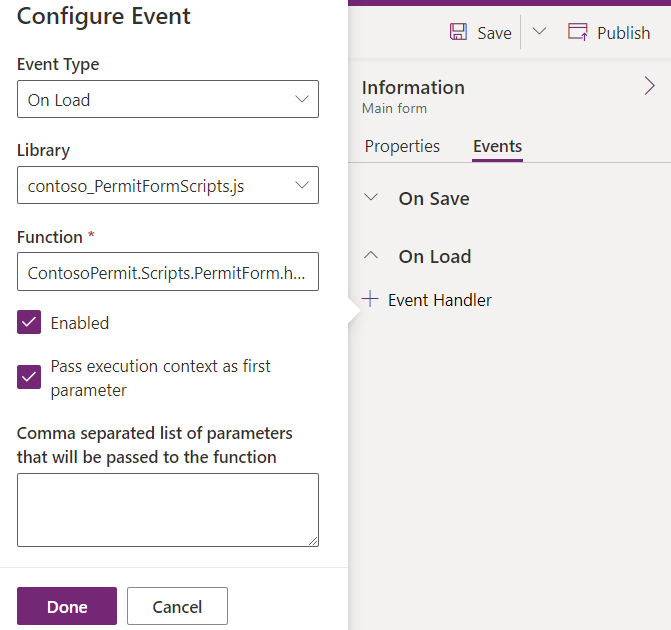
-
Add Permit Type OnChange event handler.
- Select Permit Type field on the form.
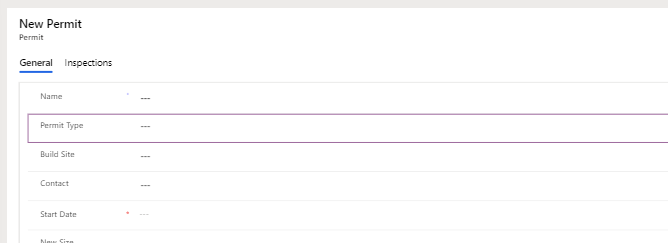
-
Go to the Properties pane and select the Events tab.
-
Expend the On Change section and select + Event Handler
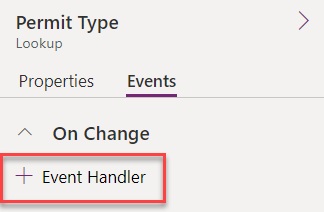
-
Select Contoso_PermitFormScripts.js for Library.
-
Enter ContosoPermit.Scripts.PermitForm.handleOnChangePermitType in the textbox for Function.
-
Check the Pass execution context as first parameter checkbox.
-
Select Done.
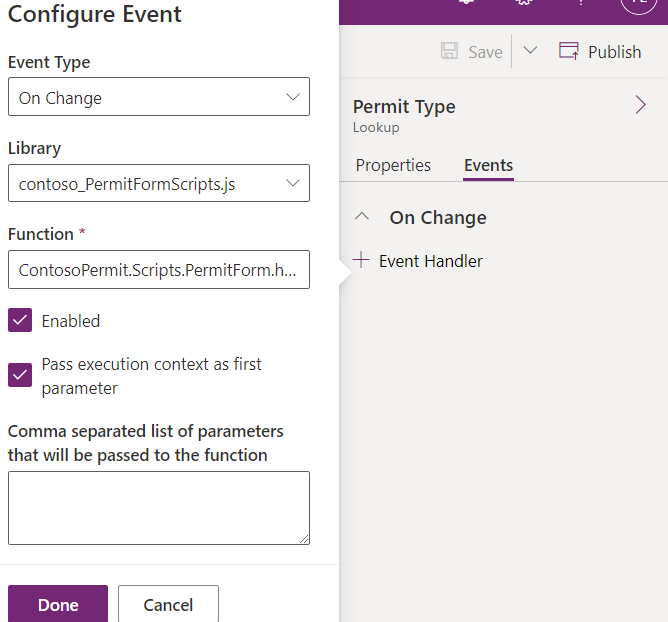
-
Save and publish your changes
-
Select Save and wait for changes to be saved.
-
Select Publish and wait for the publishing to complete.
-
Go back to the Permit table by selecting on the <- Back button.

-
Go back to the main maker portal by selecting the <- back button again.
-
Select Publish all customizations and wait for the publishing to complete.
-
DO NOT navigate away from this page
Task #4: Test Event Handlers
In this task, you will test the event handlers.
-
Start the Permit Management application
-
Select Apps.
-
Launch the Permit Management application.
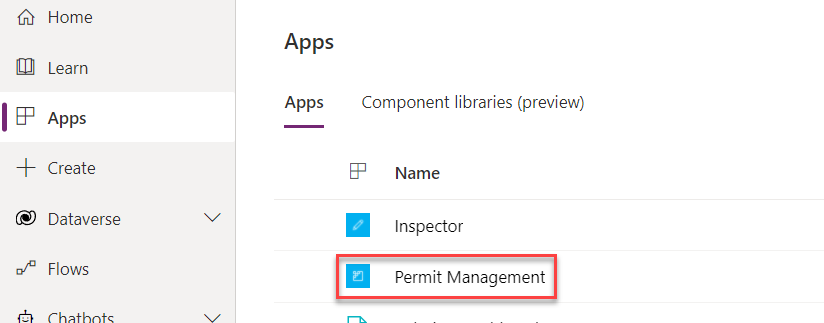
-
-
Open a Permit record
-
Select Permits from the Site Map.
-
Select to open a permit record.
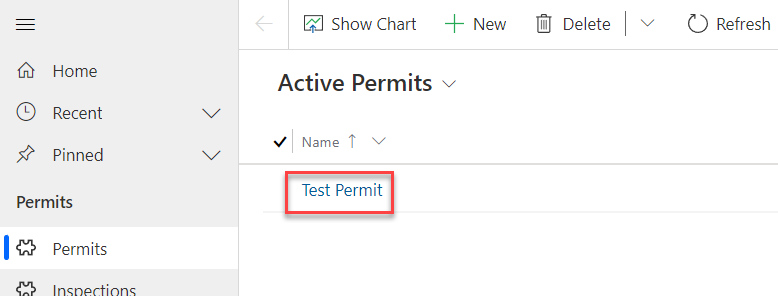
-
-
Open Edge Dev Tools
-
Press F12 or right click and select Inspect.
-
Select the Console from top menu and clear console.

-
-
Refresh and confirm the OnLoad event handler function runs
-
Go to the Permit record and select Refresh.
-
Go to the Dev Tools and you should now be able to see the on load – permit form message.

-
-
Remove Permit Type and confirm the OnChange Permit Type event handler function runs
- Go to the Permit record and remove the Permit Type.
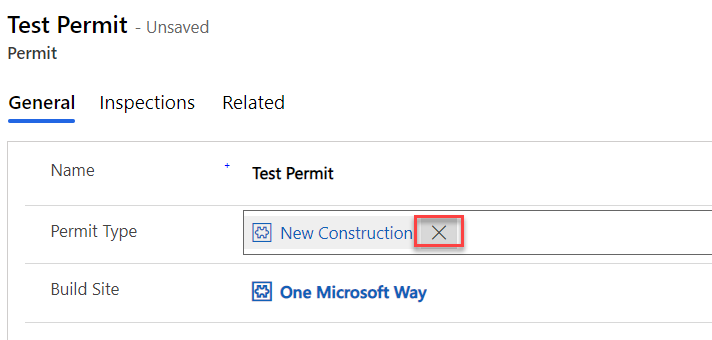
- Go to the Dev Tools and you should now be able to see the on change – permit type message.

- Close the Dev Tools.
Exercise #2: Show and Hide Tabs
Objective: In this exercise, you will create a script that will show and hide the inspections tab based on the permit type table’s “required inspections” column value.
Task #1: Create Function
-
Create a function that will run when the Permit form loads and when the Permit Type value changes
-
Go back to Visual Studio Code.
-
Add the function mentioned below to PermitFormFuntions inside the PermitForm function.
_handlePermitTypeSettings: function (executionContext) { },

-
-
Get form context from the execution context
-
Add the script mentioned below inside _handlePermitTypeSettings function.
var formContext = executionContext.getFormContext();
-
-
Get the Permit Type value from the form.
-
Add the script mentioned below inside the _handlePermitTypeSettings function. contoso_permittype is the logical name of the Permit Type column. You can verify this in the table metadata.
var permitType = formContext.getAttribute("contoso_permittype").getValue();
-
-
Check if the Permit Type has value.
-
Add the script mentioned below inside the _handlePermitTypeSettings function.
if (permitType == null) { } else { }

-
-
Hide the Inspections tab and return if Permit type is null.
-
Add the script mentioned below inside the _handlePermitTypeSettings function. inspectionsTab is the name of the Inspections tab (This is configured while creating the Model Driven App in a previous lab in this course).
formContext.ui.tabs.get("inspectionsTab").setVisible(false); return;
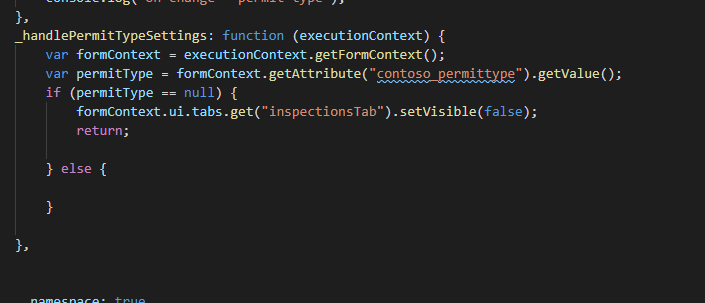
-
Task #2: Get Inspection Type Record
In this task, you will use the web API to retrieve the permit type lookup record associated with the current permit record that is currently displayed in the form.
-
Get the Permit Type ID
-
Add the script mentioned below in the else statement of the _handlePermitTypeSettings function.
var permitTypeID = permitType[0].id;
-
-
Retrieve the Permit Type record and show alert if there are errors
-
Add the script mentioned below in the else statement of the _handlePermitTypeSettings function. contoso_pertmittype is the logical name of the Permit Type table.
Xrm.WebApi.retrieveRecord("contoso_permittype", permitTypeID).then(function (result) { }, function (error) { alert('Error:' + error.message) });

-
-
Check if “Require Inspections” column value is true
-
Add the script mentioned below in the retrieveRecord function call. contoso_requireinspections is the logical name of the Require Inspections column of the Permit Type table.
if (result.contoso_requireinspections) { } else { }
-
-
Make the Inspections tab visible if Require Inspections is true
-
Add the script mentioned below in the if statement of the retrieveRecord call.
formContext.ui.tabs.get("inspectionsTab").setVisible(true);
-
-
Hide the Inspections tab if Require Inspections is not true
-
Add the script mentioned below in the else statement of the retrieveRecord call.
formContext.ui.tabs.get("inspectionsTab").setVisible(false);
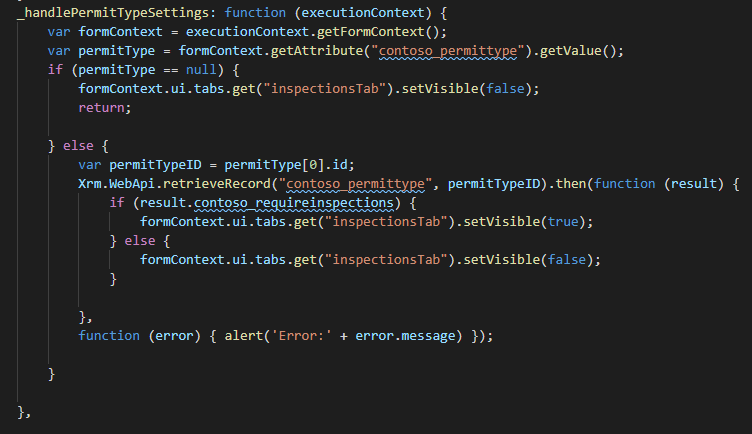
-
-
Call the _handlePermitTypeSettings function from the handleOnLoad function.
-
Go to the handleOnLoad function and add the script mentioned below.
ContosoPermit.Scripts.PermitForm._handlePermitTypeSettings(executionContext);
-
-
Call the _handlePermitTypeSettings function from the handleOnChangePermitType function.
-
Go to the handleOnChangePertmitType function and add the script mentioned below.
ContosoPermit.Scripts.PermitForm._handlePermitTypeSettings(executionContext);
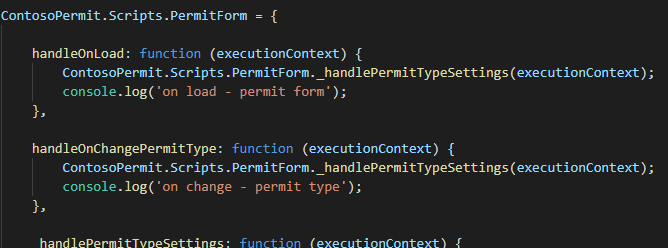
- Select File and Save All.
-
Task #3: Load Updated Script
-
Open the Permit Form Script web resource.
-
Navigate to Power Apps maker portal.
-
Select your Dev environment.
-
Select Solutions.
-
Open the Permit Management solution.
-
Select Web resources and open the Permit Form Script web resource.
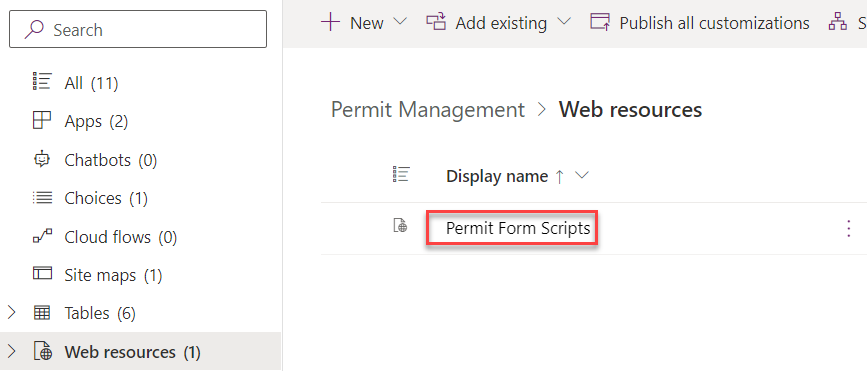
-
-
Load the updated version of permitFormFuntion.jsPermitFormFuntion.js
- Select Upload file.
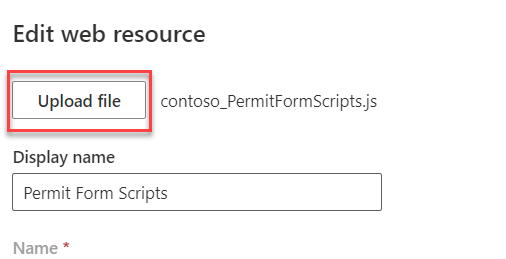
- Select PermitFormFunctions.js and select Open.
-
Save and Publish your changes
-
Select Save and wait until the changes are saved.
-
Select Publish and wait for the publishing to complete.
-
Select the <- back button to go back to the main maker portal.
-
Do not navigate away from this page.
-
Task #4: Test Your Changes
-
Start the Permit Management application
-
Select Apps.
-
Launch the Permit Management application.
-
-
Open Permit record.
-
Select Permits from the Site Map.
-
Select to open a Permit record.
-
-
Check if the Permit Type column is empty and if it is, the Inspections tab is hidden. In this case, the Permit Type is null.
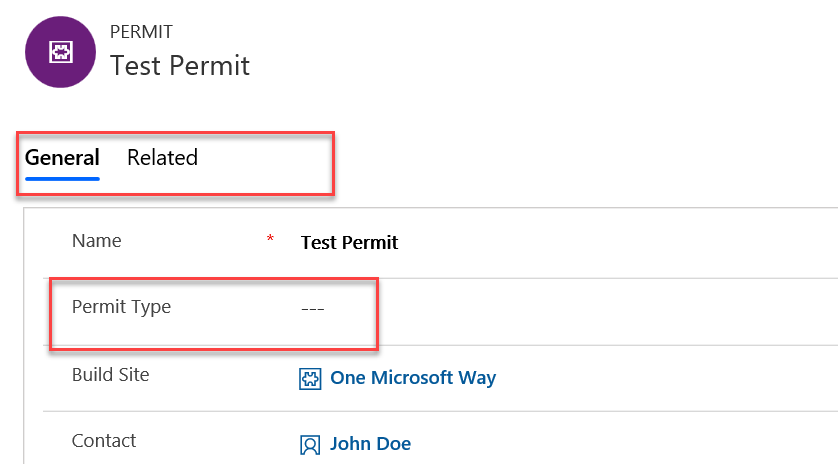
-
Select Permit Type.
-
Select the Permit Type lookup.
-
Select New Construction.
-
Check if the Inspections tab is still hidden. If so, in this case, the Require Inspections column value is false/No
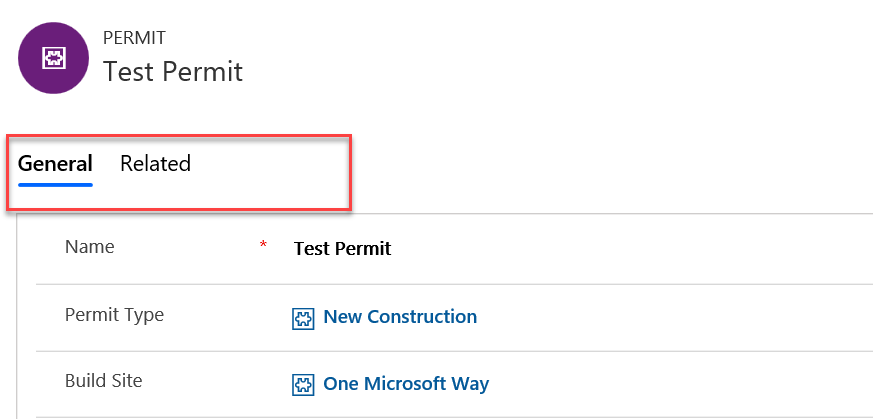
-
-
Set Require Inspections column value of the Permit Type to Yes.
- Open the selected Permit Type.
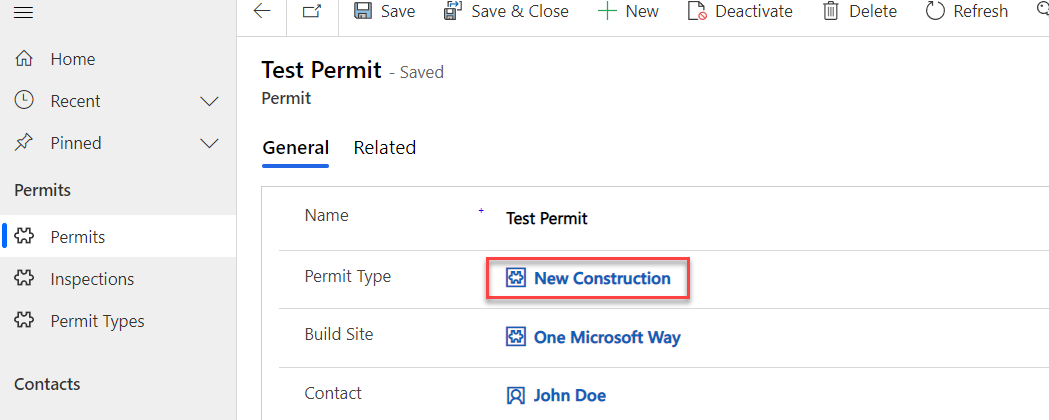
- Set the Require Inspections to Yes.
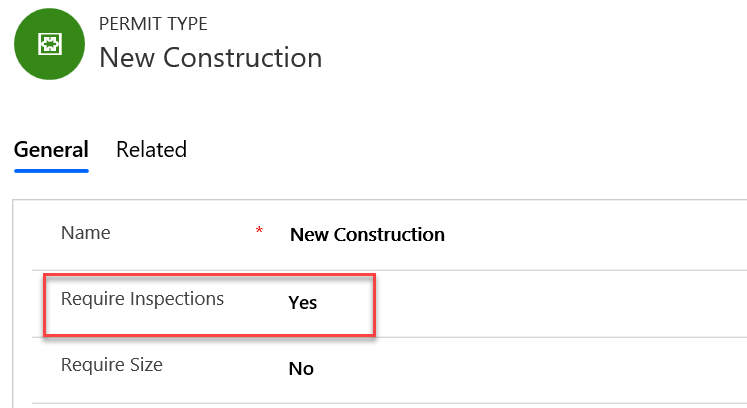
-
Select Save.
-
Select the <- back button.
-
You should now be able to see the Inspections tab.
- Select the Inspections tab.
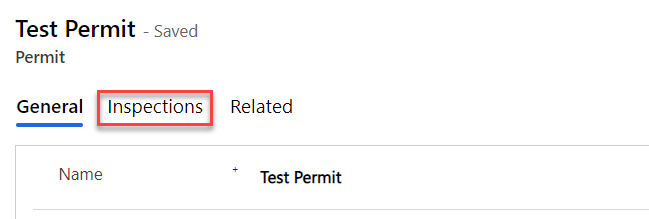
- The user should now be able to view/add inspections to the sub-grid.

Exercise #3: Toggle required property on the columns
Objective: In this exercise, you will create a script that will make the “New Size” column required when the “Require Size” column value is set to Yes. If the “Require Size” column value is set to No, remove the requirement. You will also hide the “New Size” column. This logic will be driven by a column on the permit type record that was retrieved using web API in the previous exercise.
Task #1: Create Function
-
Locate the _handlePermitTypeSettings function
-
Go back to Visual Studio Code.
-
Locate the _handlePermitTypeSettings function.
-
-
If permitType is null, remove the requirement and hide the “New Size” column.
-
Add the script below in the if permitType == null statement. contoso_newsize is the logical name of the New Size column.
formContext.getAttribute("contoso_newsize").setRequiredLevel("none"); formContext.ui.controls.get("contoso_newsize").setVisible(false);

-
-
Check if “Require Size” column value of the Permit Type is set to Yes
-
Add the script mentioned below inside the retrieveRecord function.
if (result.contoso_requiresize) { } else { }
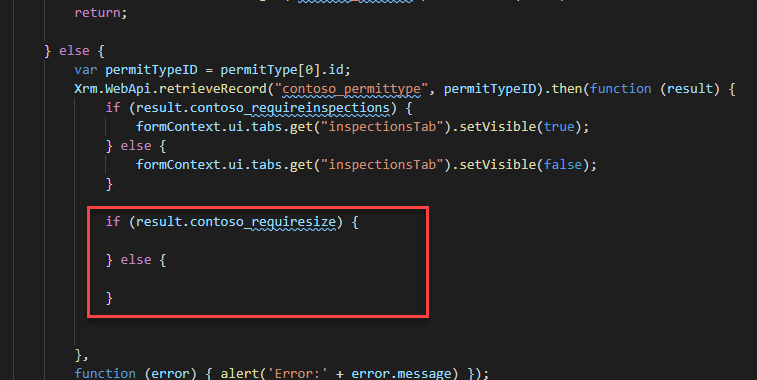
-
-
If “Require Size” column value of the Permit Type is set to Yes, make the “New Size” column visible and required.
-
Add the script mentioned below in the if result.contoso_requiresize statement. contoso_requiresize is the logical name of the Require Size column.
formContext.ui.controls.get("contoso_newsize").setVisible(true); formContext.getAttribute("contoso_newsize").setRequiredLevel("required");
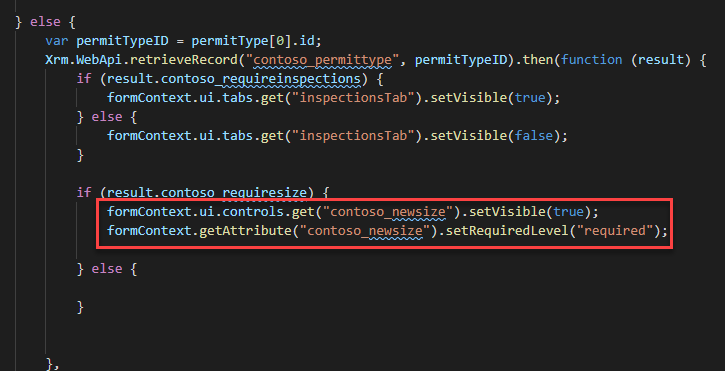
-
-
If Require Size column value of the Permit Type is not set to Yes, make the “New Size” column not required and hide it.
-
Add the script mentioned below inside the else statement.
formContext.getAttribute("contoso_newsize").setRequiredLevel("none"); formContext.ui.controls.get("contoso_newsize").setVisible(false);
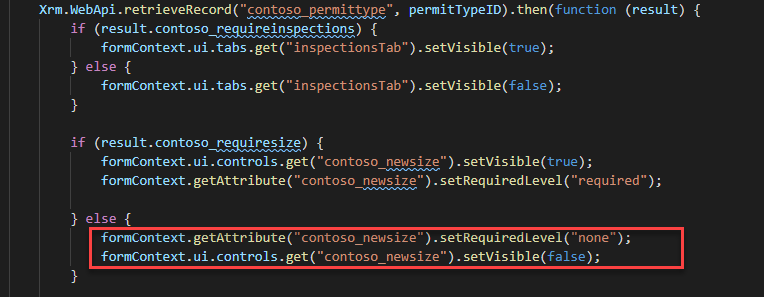
-
-
The _handlePermitTypeSettings function should now look like the image below.
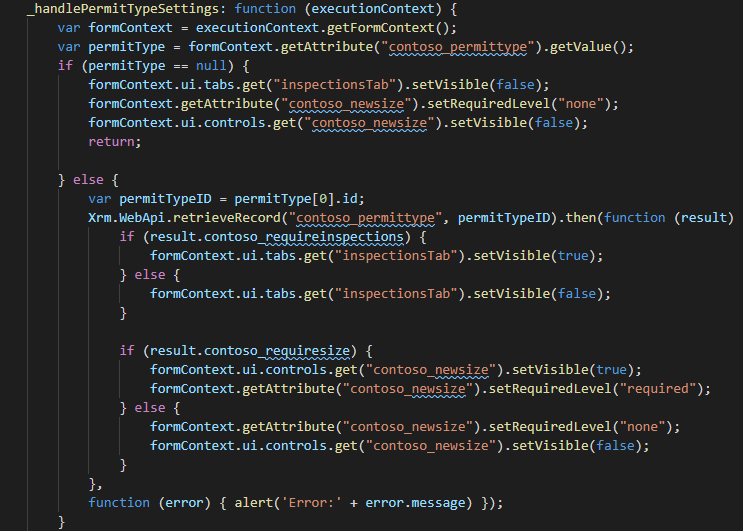
-
Select File and then Save All.
Task #2: Load Updated Script
-
Update the Permit Form Script web resource.
-
Go to the maker portal and select Solutions.
-
Open the Permit Management solution.
-
Select Web resources and open the Permit Form Scripts web resource.
-
Select Upload File.
-
Select the PermitFormFunctions.js you updated and then select Open.
-
-
Save and Publish your changes
-
Select Save and wait until the changes are saved.
-
Select Publish and wait for the publishing to complete.
-
Select the <- back button.
-
-
Do not navigate away from this page.
Task #3: Test Your Changes
-
Start the Permit Management application
-
Select Apps.
-
Launch the Permit Management application.
-
-
Open Permit record.
-
Select Permits.
-
Select to open a Permit record.
-
-
Check if the New Size column is hidden. If so, then it is because the “Require Size” column of the Permit Type is set to NO.
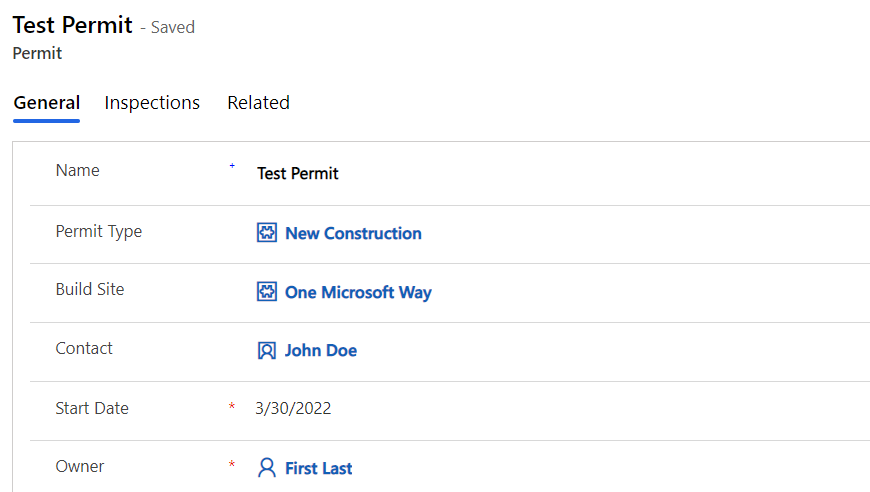
-
Set Require Size column value of the Permit Type to Yes.
- Open the Permit Type.
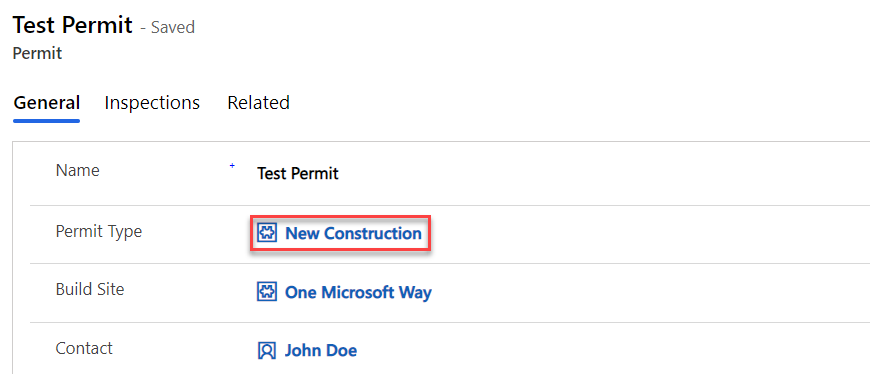
- Set the Require Size to Yes.
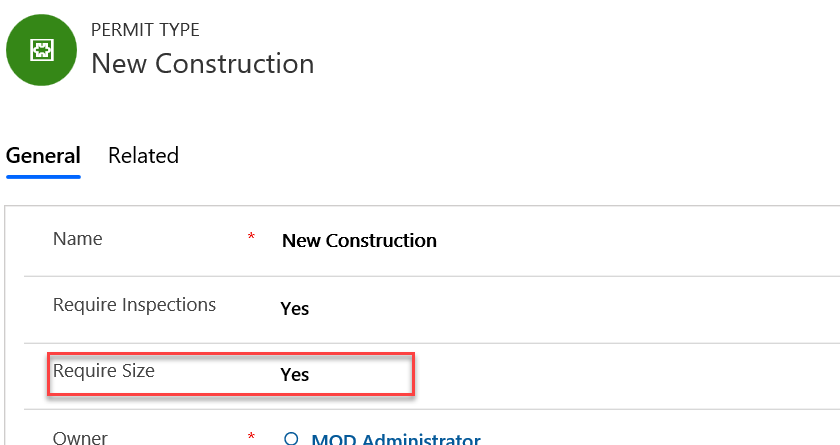
-
Select Save on the bottom right of the screen.
-
Select the <- back button.
-
Check if the “New Size” column is visible and it is marked as required.
- You should now be able to see New Size” column on the form and it is a required field.

- Remove Permit Type.
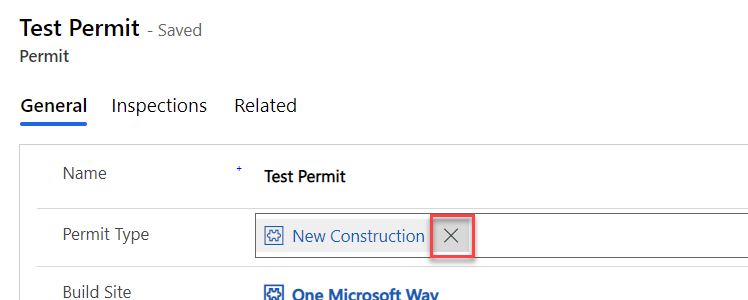
- Check if both the Inspections tab and New Size column are now hidden. They should be removed as soon as the “Permit Type” is removed.
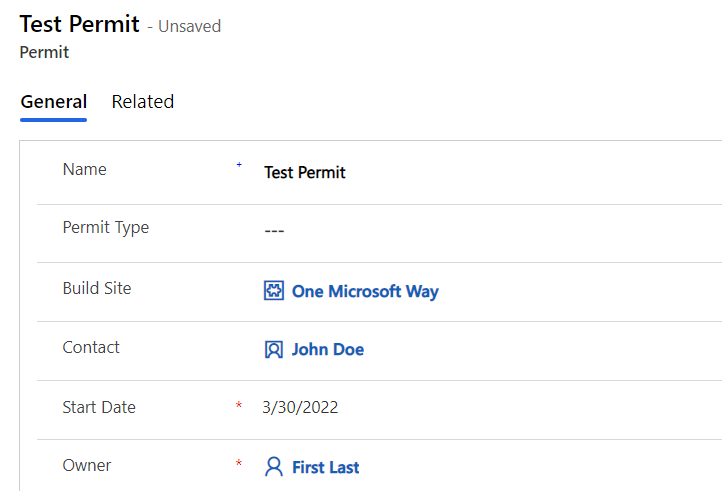
Exercise #4: Command Button Function (Optional)
Objective: In this exercise, you will you will create custom API, create a function that will lock permits, add a button to the permit table and call the lock permit function when the button is selected.
Task #1: Create Custom API
In this task, you will create a custom API that will be called to lock the permit. You will not be implementing the business logic that will lock the permit in this lab. It will be completed later in the class when you build the plug-in that registers on the custom api you are defining here.
-
Open the Permit Management Solution.
-
Navigate to Power Apps makes portal and make sure you have the Dev environment selected.
-
Select Solutions and open the Permit Management solution.
-
-
Create new custom API
-
Select + New and then select **More Other Custom API**.
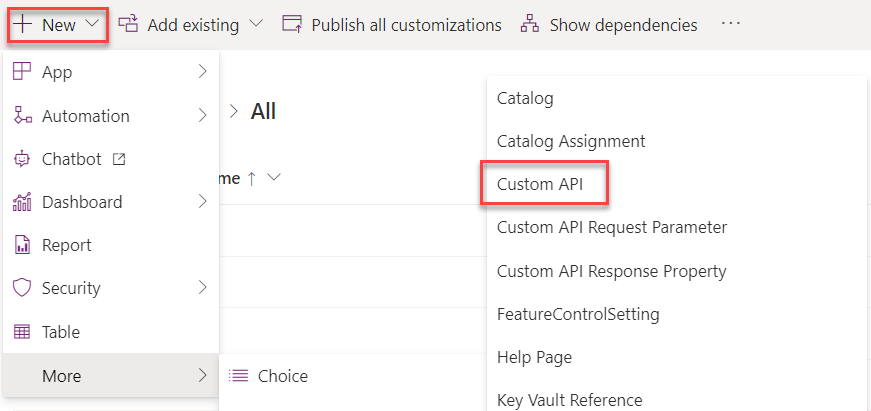
- Enter contoso_LockPermit for Unique name, enter Lock Permit for Name, Lock Permit for Display name, enter Lock Permit for Description, select Entity for Binding type, enter contoso_permit for Bound entity logical name, and select Save and Close.
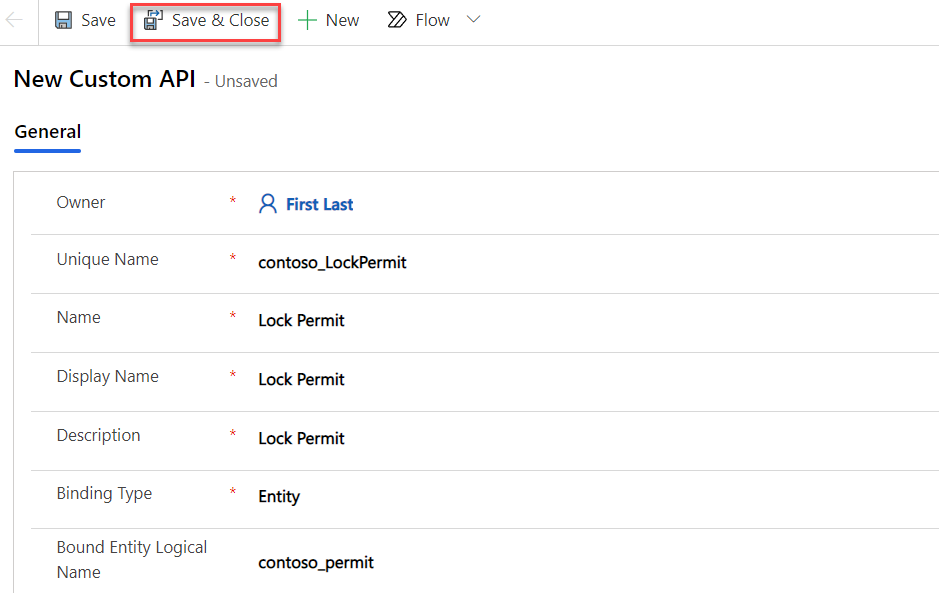
- Select Done
-
-
Create custom API request parameter
-
Select + New and then select **More Other Custom API Request Parameter**.
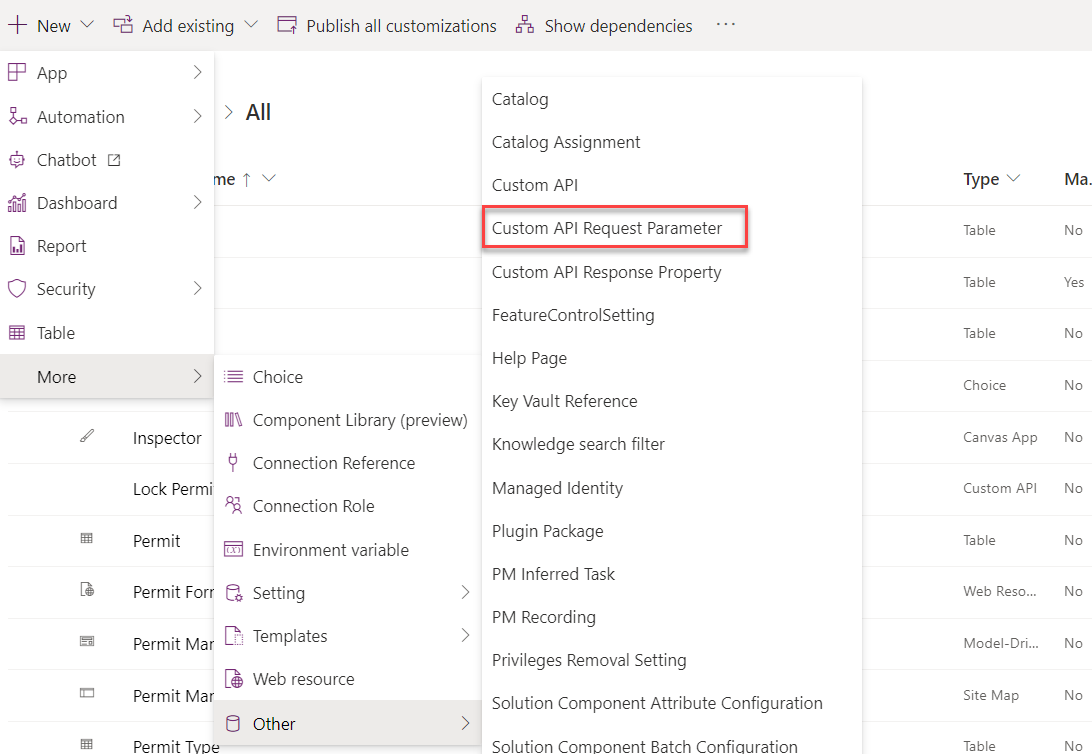
- Select Lock Permit for Custom API, enter Reason for Unique name, enter Reason for Name, enter Reason Display name, Reason for Description, select String for Type, and select Save and Close.
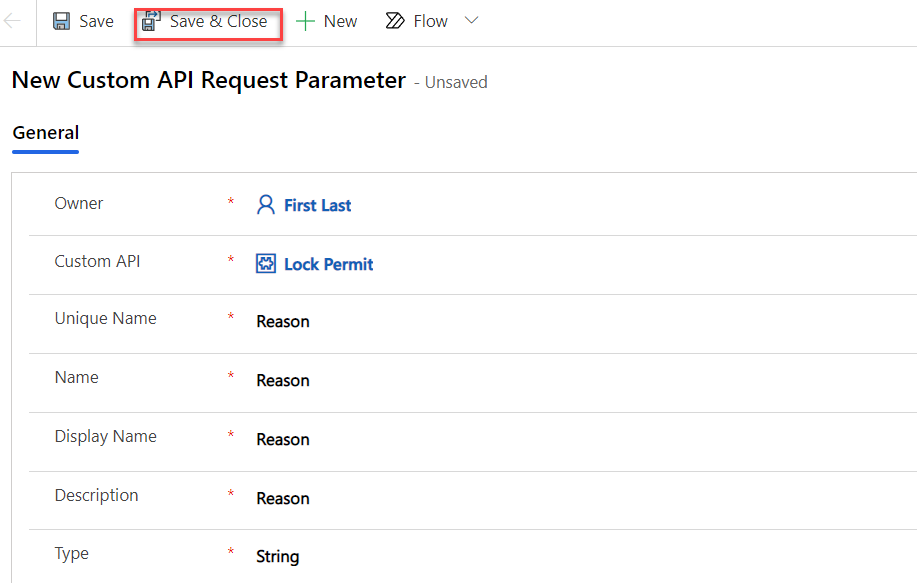
- Select Done
-
-
Create custom API response parameter
-
Select + New and then select **More Other Custom API Response Parameter**. - Select Lock Permit for Custom API, enter CanceledInspectionsCount for Unique name, enter Canceled Inspections Count for Name, enter Canceled Inspections Count Display name, Canceled Inspections Count for Description, select Integer for Type. set Yes for Is Optional, and select Save and Close.
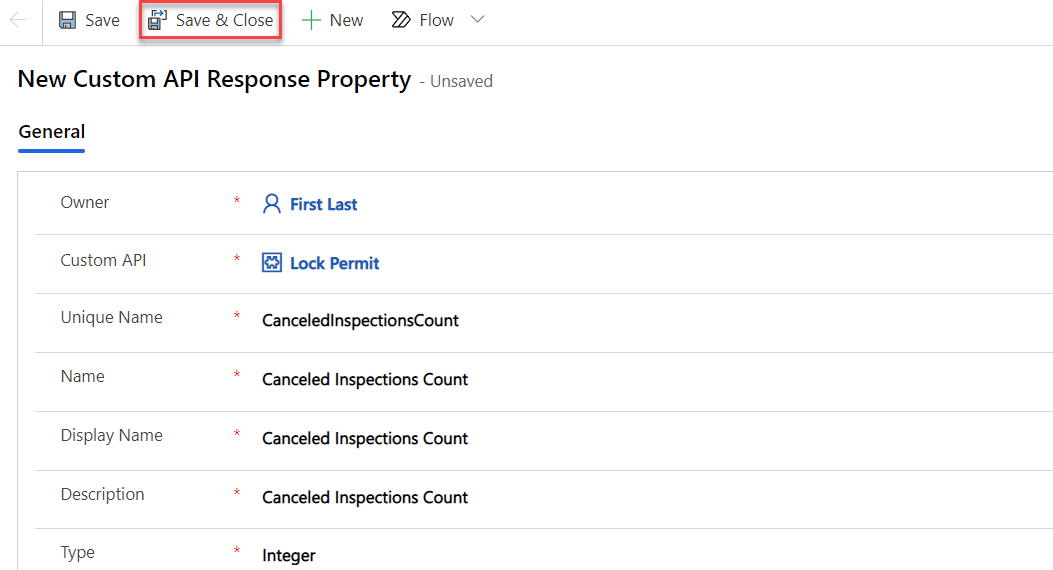
- Select Done
-
-
Publish your changes
- Select Publish all customizations and wait for the publishing to complete.
Task #2: Create the Function
In this task, you will create the logic to invoke that will call the custom API.
-
Start Visual Studio Code and open the resources you create in Exercise One
-
Start Visual Studio Code.
-
Select File and select Open Folder.
-
Select the ContosoClientScripts folder you created in exercise one and select Select Folder.

-
-
Add a function that will build the request
- Open the PermitFormFunctions.js file.
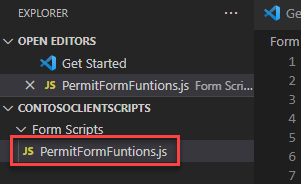
-
Add the function below after the _handlePermitTypeSettings function.
_lockPermitRequest : function (permitID, reason) { },

-
Build entity and set reason.
-
Add the script mentioned below inside the _lockPermitRequest function.
this.entity = { entityType: "contoso_permit", id: permitID }; this.Reason = reason;
-
-
Build and return the request
-
Add the script mentioned below in the _lockPermitRequest function.
this.getMetadata = function () { return { boundParameter: "entity", parameterTypes: { "entity": { typeName: "mscrm.contoso_permit", structuralProperty: 5 }, "Reason": { "typeName": "Edm.String", "structuralProperty": 1 // Primitive Type } }, operationType: 0, // This is an action. Use '1' for functions and '2' for CRUD operationName: "contoso_LockPermit", }; };
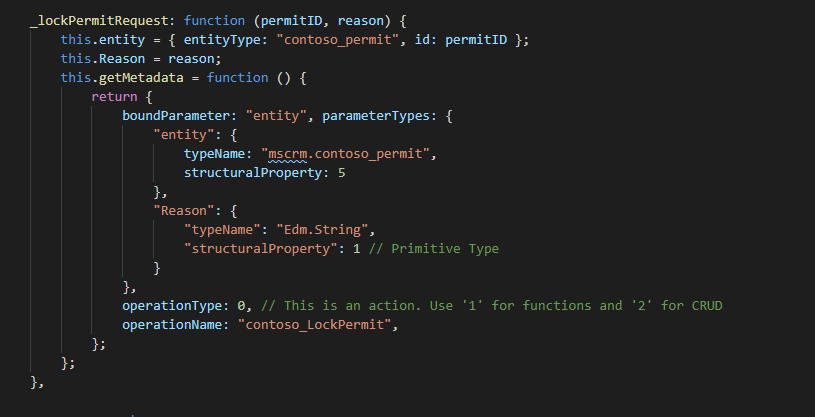
-
-
Add the function that will be called from the action button.
-
Add the function mentioned below after the _lockPermitRequest function.
lockPermit: function (primaryControl) { },

-
-
Get Permit ID and call _lockPermitRequest
-
Get the id by adding the script mentioned below inside the lockPermit function.
formContext = primaryControl; var PermitID = formContext.data.entity.getId().replace('{', '').replace('}', ''); -
Call _lockPermitRequest. We are hard-coding the reason “Admin Lock”
var lockPermitRequest = new ContosoPermit.Scripts.PermitForm._lockPermitRequest(PermitID, "Admin Lock");
-
-
Execute the request.
-
Add the script mentioned below inside the lockPermit function.
// Use the request object to execute the function Xrm.WebApi.online.execute(lockPermitRequest).then( function (result) { if (result.ok) { console.log("Status: %s %s", result.status, result.statusText); // perform other operations as required; formContext.ui.setFormNotification("Status " + result.status, "INFORMATION"); } }, function (error) { console.log(error.message); // handle error conditions } );
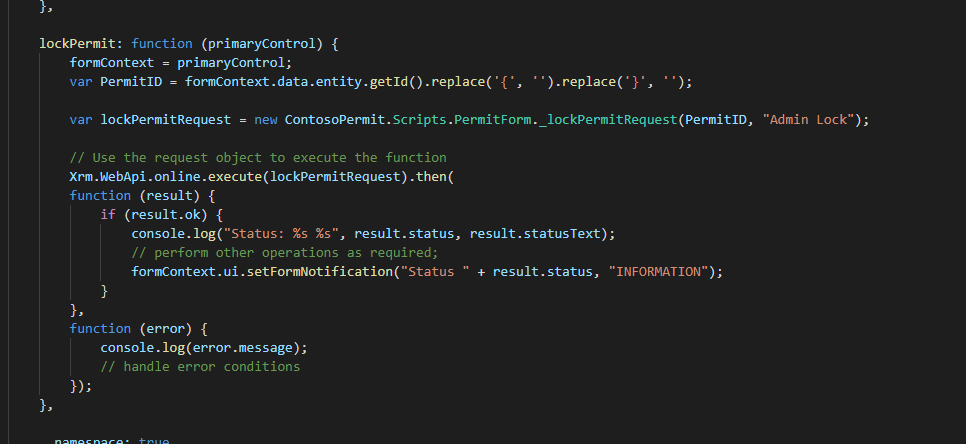
- Select File and then Save All.
-
-
Load the update resource and publish.
-
Log on to Power Apps maker portal and make sure you have the Dev environment selected.
-
Select Solutions and open the Permit Management solution.
-
Select Web resources and open the Permit Form Scripts web resource.
-
Select Upload File.
-
Select the PermitFormFunctions.js you updated and select Open.
-
Select Save and wait until the changes are saved.
-
Select Publish and wait for the publishing to complete.
-
Task #3: Add Button to Ribbon
-
Open the Permit Management application for edit
-
Sign in to Power Apps maker portal and make sure you have the Dev environment selected.
-
Select Solutions and select to open the Permit Management solution.
-
Select Apps and select the Permit Management application.
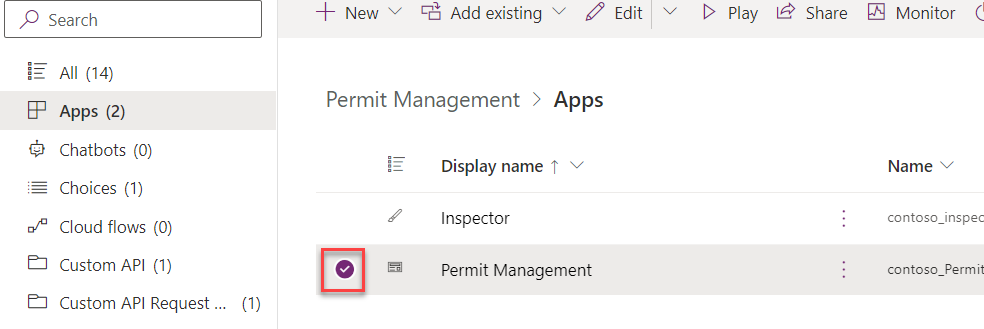
-
Select the chevron button next to the Edit button and select Edit in preview.

-
-
Edit the Permit table command bar.
-
Select the Pages tab, Hover over the Permit table and select the … button.
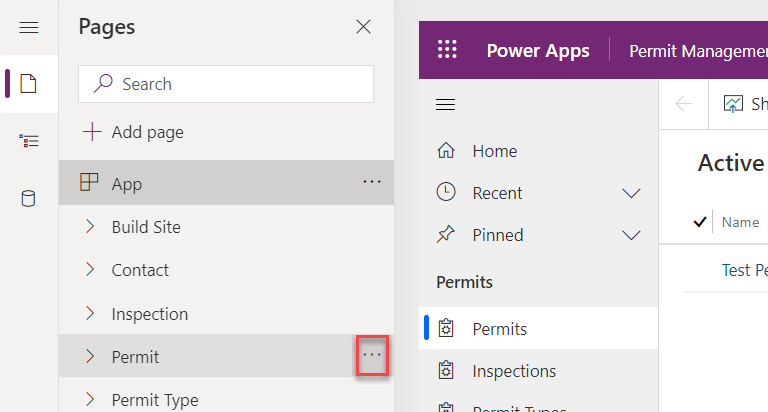
-
Select Edit command bar.

-
Select Main form and then select Edit.
-
-
Add command to permit table
- Select + New command.
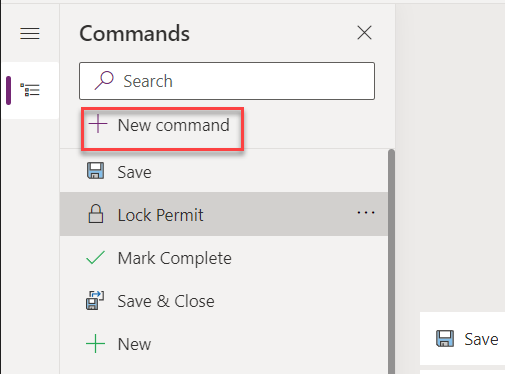
- Select JavaScript and then select Continue.
-
Configure command bar button
- Enter Lock Permit for Label, Select Use Icon, select Lock for Icon, and enter Lock Permit for Tooltip,
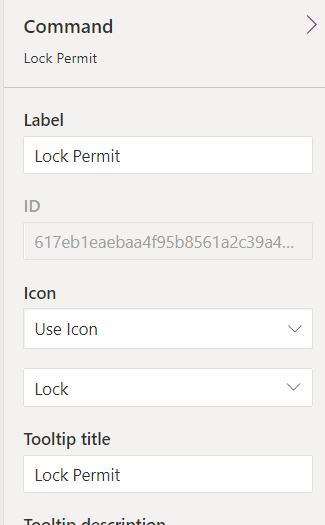
- Scroll down and select + Add library

- Search for contoso, select Permit Form Scripts, and then select Add.
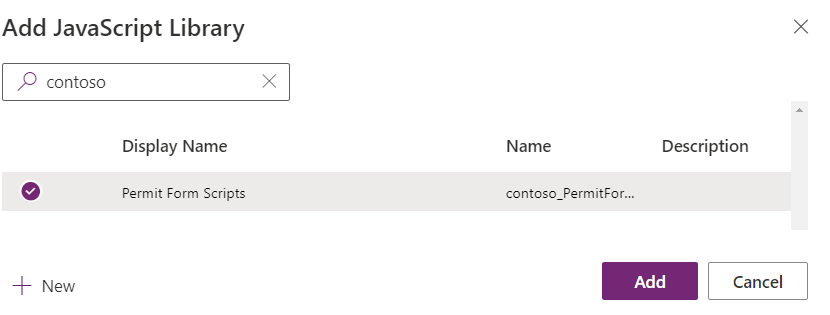
- Enter ContosoPermit.Scripts.PermitForm.lockPermit in the textbox for Function Name.
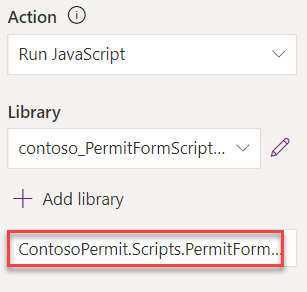
-
Add parameter
- Select + Add Parameter .
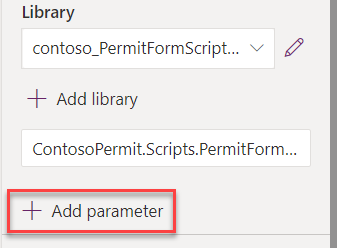
- Select PrimaryControl for Parameter 1.
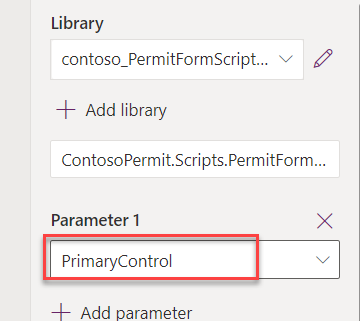
-
Publish your changes.
- Select Save and Publish.
Task #5: Test Command Button
-
Start the Permit Management application.
-
Log on to Power Apps maker portal and make sure you have your Dev environment selected.
-
Select Apps and launch the Permit Management application.
-
-
Open a permit record
-
Select** Permits**.
-
Select to open a permit.
-
You should be able to see the button you just added.

-
-
Test the Command
-
Select the Lock Permit button.
-
The script should trigger the action and you should be able to see the Status 200 notification.

-